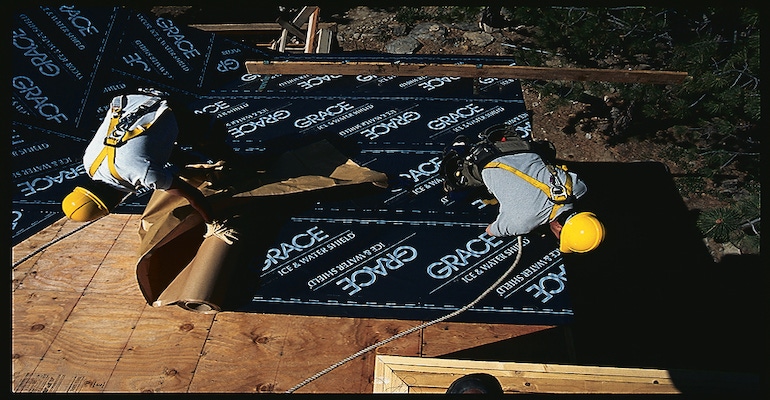The type of self-adhered roofing underlayment used has a big impact. It is critical that contractors take a close look at the two categories—granular self-adhered underlayment and smooth self-adhered underlayment—to determine which one is best for their project. Here is a breakdown of the features of both.

Since introduced well over 100 years ago, there have been numerous advances in the design of roofing underlayments. However, similar to the placement of these materials, these innovations have remained under the surface without significant exposure or recognition. Roofing underlayments have come a long way and are now a critical part of a building’s overall roof system.
Many homeowners and contractors believe that because a roofing product has met all the requirements of the building code that it is a good choice, but the building code represents the minimum level of performance required. There are significant differences in performance depending on how the product is constructed. An important consideration that contractors should keep in mind when selecting a self-adhered roofing underlayment is the surface: granular or smooth.
The surface of a self-adhered roofing underlayment has a big impact on the application of the underlayment, as well as on future re-roofing. Thus, it is critical that contractors take a close look at the two categories to determine which one is best for their project. Here is a breakdown of the features of a granular self-adhered underlayment and a smooth self-adhered underlayment:
GRANULAR UNDERLAYMENTS
Granular self-adhered underlayments have a sand-like surface. They are heavy with a thickness ranging from 40-60 mils. This type of underlayment has grown in popularity, as it is perceived that they are slip-resistant and they are generally sold at a lower price.
Many contractors and roofers are comfortable with the granular underlayment because they work with asphalt shingles all the time. They like the thickness, believing that it makes it easier to install, and more durable. However, there are four considerations regarding granular underlayments to be aware of:
After exposure, the granules can become loose and spread over the surface of a sloped roof, creating a slip hazard.
Granular underlayments tend to soften on hot sunny days. This creates the risk that oil and adhesive may be transferred from the surface of the underlayment onto the decorative roof covering, such as the shingles.
A granular surface is very rough and uneven, making it difficult to adhere to itself at overlaps and to create watertight laps. Frequently, granular underlayments require roofers to use roofing cement to bond these overlaps and end laps to improve watertightness. This step is messy and often overlooked by the installer.
Granular underlayments are double the weight of smooth underlayments. They are usually 65 pounds compared to 30-50 pounds for a smooth underlayment roll with the same dimensions. The heavier weight translates to more labor and time to carry the roll up a ladder to the rooftop, making for a more labor-intensive installation.
SMOOTH UNDERLAYMENTS
Smooth self-adhered underlayments are also often referred to as film surface underlayments. Their smooth surface provides benefits when it comes to waterproofing a roof. They seal aggressively to roof decks and around roof fasteners to prevent leaks and create a watertight bond. Other smooth underlayment features to consider are:
They easily adhere to the next membrane layer at overlaps, making it easy to form strong and watertight laps without using roofing cement or sealants.
Smooth surface underlayments have multiple levels of performance to choose from. For example, self-adhered roof underlayments have a thick layer of aggressive adhesive, offering the ultimate level of protection and are designed to perform even in severe alpine and coastal environments. They deliver the protection, economy and ease of installation typical of the granular membranes without its drawbacks: it is lighter weight; watertight laps can be easily formed due to the smooth film surface; it has no granules that can become loose; and it won’t track oil onto the roof covering on a hot day.
When it comes time to replace a roof, smooth surface underlayments are re-roofable. Unlike granular underlayments, you don’t need to remove the existing underlayment or cut the area out. Simply apply a new layer of smooth underlayment over the old smooth underlayment.
Smooth underlayments are lightweight, 30-50 pounds for the same roll size, making it easier to haul up to a roof, reducing labor time and cost.
KEY TAKEAWAYS
It is important to take the time to examine the multiple product types out there, first studying whether a granular or smooth surfaced underlayment is the better fit. Ask yourself the following questions
What level of protection does the job require?
What surface is ideal for application and securing overlaps?
What is safest for my crew?
What would the homeowners prefer for re-roofing in the future?
The primary consideration shouldn’t only be about what is cheaper, but what product will protect your reputation and will provide long-term quality and performance for the homeowner.
Read more about:
underlaymentsAbout the Author(s)
You May Also Like




